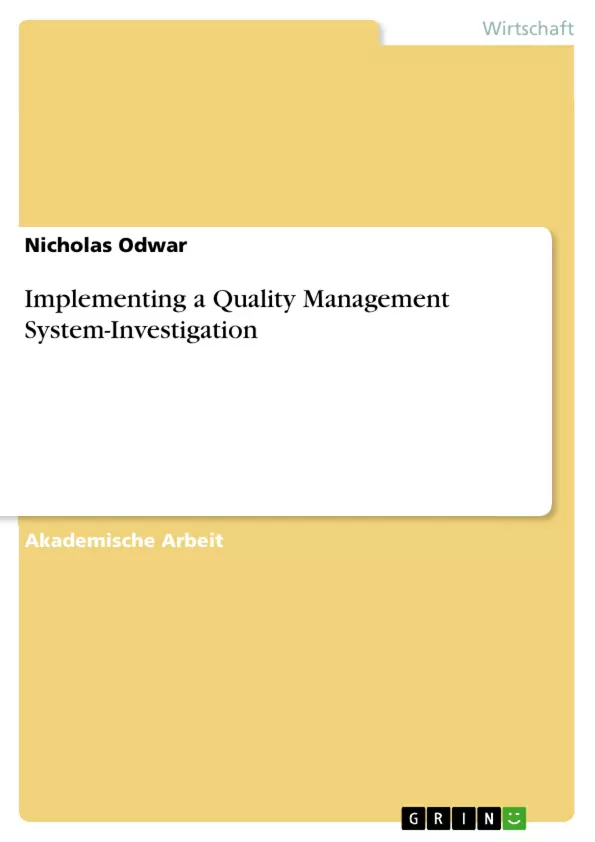The primary aim of this study is to investigate how “Quality Management Systems” (QMSs) support an organization to manage cultural issues and challenges of its implementation.
A quality management system (QMS) describes a formalized system that documents, procedures and responsibilities for attaining quality regulations and objectives. A QMS aids in coordinating and directing a company's activities to meet the client and regulatory requirements as well as enhance its efficiency on a constant basis. Generally, quality management systems are aligned with a company's purpose and strategic direction. Such systems are usually repeatable and assessable and depend on incessant improvement. By applying a quality management system, companies can detect and tackle problems earlier in the production procedure, decreasing the possible defects and the need for rework or scrapping of products. As a result, it decreases the "Cost of Poor Quality" (COPQ) linked to scrap, rework as well as returns. A QMS improves communication and collaboration among employees by providing a shared understanding of the company's processes, policies, and procedures. By applying a quality management system, a business can detect and get rid of inefficiencies in their procedures, decrease waste, enhance supplier quality by making it easy to rate and communicate with suppliers as well as streamline their operations and ease change management in the organization. These systems also offer a structured way of managing risk, which can aid the company in detecting prospective operational risks and reducing their effect on the organization. As a result, it enhances workflow efficiency. Furthermore, companies have today considered the application of quality management systems to enhance communication and collaboration among workers by offering a shared comprehension of the organization’s procedures, and regulations ensuring that all workers are on the same page (Saragih et al., 2020). This shared comprehension can assist in getting rid of confusion, decrease flaws, and enhance the general quality of the organization’s production. In the twenty-first century, the quality management system seemed to join with sustainability and transparency initiatives, as both investor and client gratification and supposed quality are progressively connected to these aspects. This research majorly focuses on assessing the advantages and challenges that come with implementing a quality management system.
Inhaltsverzeichnis
- Abstract
- GLOSSARY.
- CHAPTER 1: INTRODUCTION…...
- 1.1 Background to the research..
- 1.2 Research Question ...
- 1.3 Aims.
- 1.4 Objectives....
- 1.5 Literature Gap………..\li>
- 1.6 Structure of the Dissertation
- CHAPTER 2: RESEARCH METHODOLOGY AND LITERATURE REVIEW
- 2.1 Methodology Section
- Introduction.....
- Research Framework..
- Research philosophy and Justification.....
- Research approach and Justification.....
- Research Strategy and justification.....
- Data collection
- Selection Criteria....
- Data analysis
- Sampling.......
- Research limitations...\li>
- Ethical consideration.
- LITERATURE REVIEW
- Benefits of Quality Management Implementation
- Challenges of Quality Management Implementation
- CHAPTER 3: FINDINGS AND DISCUSSION
- 3.1 Findings section.....
- 3.1.2 Introduction
- 3.1.3 Thematic Analysis....
- 3.1.4 Hypothesis Generation.....
- 3. 2 Discussion section
- 3.2.1 Procedure of Quality Management System implementation
- 3.2.2 Benefits of Quality Management System (QMS) implementation ..
- 3.2.3 Challenges/disadvantages linked to the implementation of QMS.....
- 3.2.4 Quality Management Systems frameworks
- 3.2.4.1 ISO 9001 Quality Management System......
- 3.2.4.2 Total Quality Management (TQM) ..
- 3.2.4.3 The Six Sigma......
- 3.2.4.4 Lean Management
- 3.2.4.4 Kaizen
- CHAPTER 4: CONCLUSION and RECOMMENDATIONS .
- 4.1 Conclusion
- 4.2 Recommendations
- References..
- GLOSSARY
Zielsetzung und Themenschwerpunkte
Die vorliegende Forschungsarbeit untersucht, wie Qualitätsmanagementsysteme (QMS) Unternehmen dabei unterstützen, kulturelle Probleme und Herausforderungen bei der Implementierung zu bewältigen.
- Die Auswirkungen von QMS auf die Unternehmenskultur
- Die Vorteile der Implementierung eines QMS
- Die Herausforderungen und Nachteile der QMS-Implementierung
- Verschiedene QMS-Frameworks wie ISO 9001, TQM, Six Sigma und Lean Management
- Die Rolle der Führungskräfte bei der erfolgreichen Implementierung von QMS
Zusammenfassung der Kapitel
Kapitel 1 bietet eine Einführung in das Forschungsthema, einschließlich des Hintergrunds, der Forschungsfrage, der Ziele und der Literaturlücke. Kapitel 2 beschreibt die Forschungsmethodik und die Literaturrecherche, einschließlich der systematischen Literaturübersicht, des Forschungsrahmens, der Datenerhebung und der Datenanalyse. Kapitel 3 präsentiert die Ergebnisse und die Diskussion der Untersuchung, einschließlich der thematischen Analyse, der Hypothesengenerierung und der Analyse der Vorteile und Herausforderungen der QMS-Implementierung. Kapitel 4 bietet eine Zusammenfassung der Forschungsergebnisse und Empfehlungen für die Praxis.
Schlüsselwörter
Qualitätsmanagementsystem (QMS), Auswirkungen von Qualitätsmanagementsystemen, Vorteile von Qualitätsmanagementsystemen, Nachteile von Qualitätsmanagementsystemen, Kosten der schlechten Qualität (COPQ), Kosten der Qualität (COQ), ISO 9001, Total Quality Management (TQM), Six Sigma, Lean Management, Kaizen.
- Quote paper
- Nicholas Odwar (Author), 2024, Implementing a Quality Management System-Investigation, Munich, GRIN Verlag, https://www.hausarbeiten.de/document/1487222


